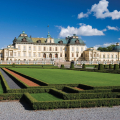This elegant palace on the shores of Lake Mälaren has been the residence of the royal family since 1981. Built in place of the previous castle which was destroyed by fire, this baroque building is the pride of the Swedish Crown. The architect Nicodemus Tessin the Elder designed the plans commissioned by Queen Hedwig Eleanor, who found the old castle too crude and medieval to accommodate foreign representatives. In 1662, she began the work that, a century later, would give the building its definitive shape, orienting the decoration towards the French Rococo style.
The great hall. All in fake marble and trompe l'oeil, populated with busts of Roman emperors, goddesses and fake reliefs, this space deserves a good observation, in order to catch the details of the frescoes and try to restore this timeless style. Just to the left are the apartments of the Swedish king, where he lives with his family in winter.
The ceremonial room of Hedwig-Eleonora. Without doubt the most sumptuous room in the castle and one of the most expensive in Europe. An absolute expression of the baroque style, with golden ornaments, symbols of royal power. On the ceiling, a fresco with two hands joining represents the meeting in heaven of Eleonora and her husband Charles XI, who died in 1660.
The Chinese room. A curiosity that reveals the fascination of King Gustav III for China. The local artists created, by copying the Chinese style, the art which will take the name of "chinoiserie". Here is an excellent example of this trend, through a stove as surprising as ingenious.
Oscar's room. On the walls are stretched tapestries with powerful colors. They are the wedding gifts of Edwige Eléonore, found by Oscar II more than 200 years later. The tapestries tell the Greek legend of the priestess Hero and her lover Leander, who swims across the sea from his beloved every night. One day a storm breaks out but Léandre attempts to cross and drowns. When his body washes up on the shore, she lets herself die of grief.
The Throne Room. Renovated at the initiative of Oscar I, son of Jean-Baptiste Bernadotte. The monarch, no doubt wanting to place his kingdom among the greatest, displayed his portrait framed by those of Napoleon III and Queen Victoria of Great Britain. With its high ceilings, this room would have been used to play badminton.
Did you know? This review was written by our professional authors.
Members' reviews on DROTTNINGHOLMS SLOTT (DROTTNINGHOLMS CASTLE)
The ratings and reviews below reflect the subjective opinions of members and not the opinion of The Little Witty.

























